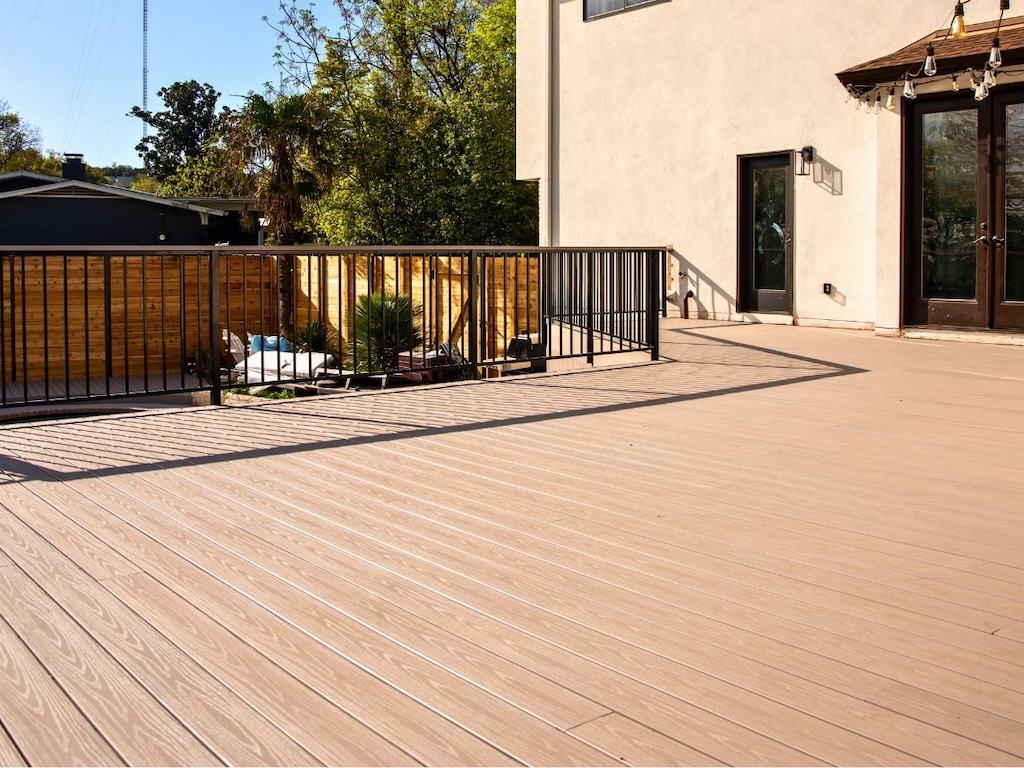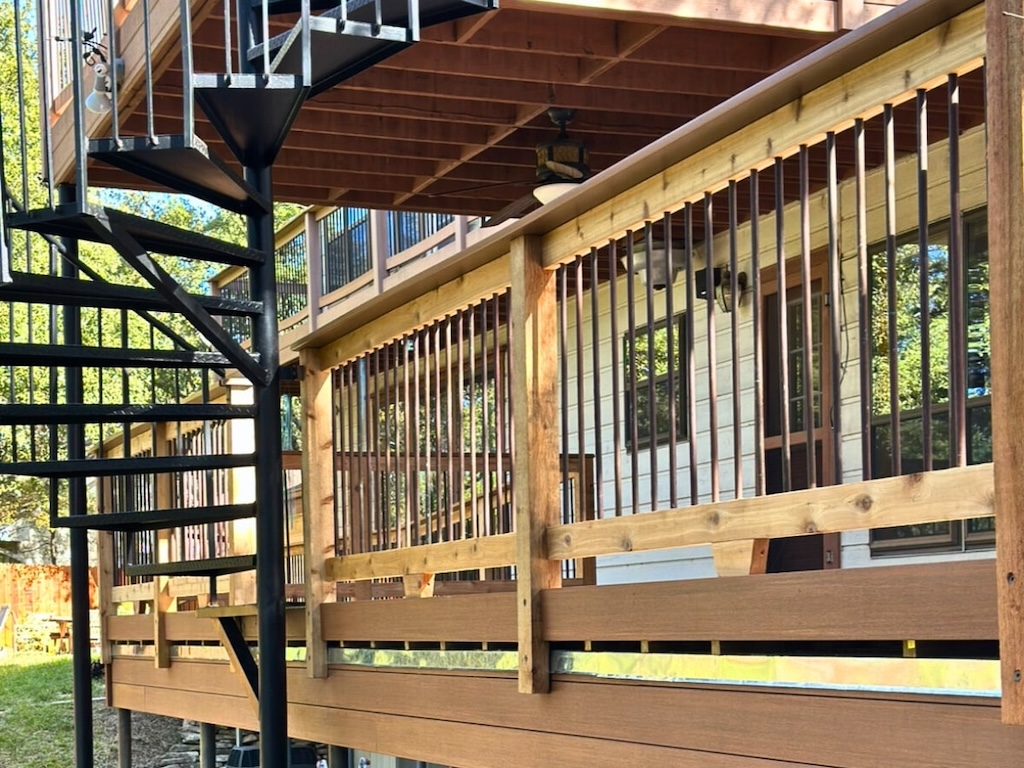TL;DR
Austin’s deck “sweet spots” are late fall through early spring (roughly October–April) for faster scheduling, cooler crew temps, and optimal finish windows for wood. Late spring and early summer can still be great if you plan ahead, lock materials in, and design for heat/UV. Mid-summer works—but you’ll sequence tasks differently to protect materials and people. For a sense of how a specialist plans around Austin’s seasons for your deck project , browse the process and portfolio on Ace Deck Builders.
Table of Contents
ToggleAustin’s Climate Reality (and Why It Matters)

Austin isn’t a mild, coastal climate. Expect high UV, long hot spells, sudden storms, and occasional cold snaps. These variables change how quickly crews can work, when finishes cure best, and how long materials survive uncovered in austin’s heat . Choosing your install window isn’t just about getting it done—it’s about how well your deck performs five and ten years from now.
In short: pick a season that matches your deck’s materials, exposure, and features for an optimal outdoor living space —and work with a pro who sequences inspections and finishes to that reality.
The Four Seasonal Windows (Pros, Cons, and What to Expect)
1) Late Fall (October–November)
Why homeowners love it:
- Cooler temps for crews and adhesives/finishes.
- Often shorter booking queues post-summer rush.
- Great time to build for holiday entertaining or a spring debut.
Watchouts:
- Pre-Thanksgiving rush can compress inspection calendars; plan submittals early.
- Daylight savings reduces working light—schedule tasks accordingly.
Pro tip: If pressure treated wood is your choice, late fall framing with finish application on a mild, dry spell gives stain the best chance to penetrate and cure.
2) Winter (December–February)
Why it’s a sleeper hit:
- Historically faster permitting and inspection availability.
- Cooler climate means crews can sustain productive hours.
- Composite installations are straightforward; wood finishing may wait for milder dry windows (which still occur in Austin winters).
Watchouts:
- Holiday closures (city/HOA/vendors) require calendar awareness.
- Occasional cold snaps can pause finish work; a good builder resequences tasks (e.g., rail install or lighting rough-in).
Pro tip: Build now, party later—a winter install sets you up for spring use without fighting peak-season queues.
3) Spring (March–May)
Why it’s popular:
- Great balance: moderate temps + longer daylight.
- HOA boards are fully “back at it,” making submissions more predictable.
- You’ll be ready for Memorial Day and summer.
Watchouts:
- High demand can stretch start dates.
- Storm bursts are more likely; you’ll want a crew with strong weather protocols (staging, bracing, covers).
Pro tip: Lock materials and railing kits early. If a back-order hits in spring, it can slide you into summer.
4) Summer (June–September)
Yes, you can build—smartly.
- Longer days can offset some heat-related slowdowns.
- Composite and PVC installs continue; crews shift to earlier or later dayparts.
- If you’re targeting back-to-school or fall events, a July start can make sense if materials are ready.
Watchouts:
- Heat slows finish work for wood (curing windows matter).
- Crew safety requires adjusted schedules and more breaks—plan for it.
- Popular composites in trending colors may have longer lead times.
Pro tip: Choose lighter-tone boards and bake shade into the design (pergola orientation, privacy panels, tree canopies) for a low maintenance outdoor area . Your feet—and guests—will thank you.
Timeline & Permit Considerations by Season

- Fall & Winter: City desks and inspection calendars often move quicker; permit reviewers love clean drawings and ready answers. HOA boards meet reliably outside major holiday weeks—submit before closures.
- Spring: Expect volume. A complete, code-clear plan set is the difference between a one-touch approval and a slow email ping-pong.
- Summer: Inspectors are busy; book footings and framing inspections mid-week to avoid Monday/Friday pileups.
For a step-by-step view of submittals, hold points, and how a specialist manages approvals, review this overview of deck installation in Austin while you’re weighing dates.
Material Notes by Season (Cedar, Composite/PVC, Ipe)
Cedar & Other Softwoods
- Fall/Winter: Ideal for installing framing/decking with less thermal stress. Pick clear, mild days to stain or seal; if a cold snap looms, your builder can shift finish to the next favorable window.
- Spring: Good curing weather; watch rain windows.
- Summer: Still fine, but stain/seal may need early-morning or evening applications and longer cure times.
Composite & PVC
- Year-round friendly with proper gapping and ventilation.
- Heat expands boards more in summer—experienced crews account for this during install.
- Lighter hues run cooler; consider tread textures for barefoot comfort.
Hardwoods (e.g., Ipe)
- Fall/Winter/Spring: Excellent; controlled install temps make fasteners happier.
- Summer: Prioritize pre-drilling, proper bit management, and sun protection for stock on site.
Comfort & Shade Planning (Beat the Heat Before It Beats You)

A deck that’s exquisite at dusk can be brutal at noon if you don’t plan for heat. The “best time” to install is also the best time to design for comfort:
- Orientation: Angle boards and seating to catch prevailing breezes and dodge harsh western sun.
- Shade elements: Pergolas, retractable canopies, and privacy panels that double as wind control.
- Surface temp management: Lighter decking tones, open under-deck ventilation, and thoughtful railing cap materials.
- Lighting: Low-glare bollards, step lights, and dimmable circuits for evenings when temps drop.
Unsure whether your current structure is worth keeping until a cooler season? A professional wood deck installation overview can help you understand build sequencing and finish timing for natural materials.
If you’re deciding now vs. fall, this quick homeowner piece—why fall is the perfect time for a deck upgrade—covers planning advantages, scheduling realities, and comfort wins.
Speed & Budget: How Seasonality Impacts Cost
- Labor efficiency: Cooler months mean more productive hours per day; you’ll see smoother momentum.
- Supply promos: Manufacturers sometimes run shoulder-season incentives on composites/rail kits.
- Change orders: These expand timelines in any season; lock selections early to avoid re-pricing and re-sequencing.
- Stain cycles: If you choose wood, plan your maintenance schedule around seasons that favor drying/curing—usually fall or spring.
HOA, Inspections, and Lead Times (When Bureaucracy Moves Fastest)
- HOA: Submit complete packets (plan, elevations, color/finish samples). HOA boards move faster when you answer everything once.
- Inspections: Aim for mid-week; keep ledger connections and footing holes fully exposed—nothing slows a project like re-opening covered details.
- Lead times: Reserve rail systems and special-order fascia early in spring and summer; shoulder seasons are more forgiving.
If you’re weighing quick fixes now versus a full build later, a pragmatic look at deck repair in Austin explains when targeted repairs buy you a season (or three) without sinking money into a dead-end.
Homeowner To-Dos That Keep Seasonal Schedules Tight
- Batch decisions on layout, rail style, lighting, and color before procurement.
- Approve drawings quickly—every roundtrip adds days.
- Coordinate access (gates, pets, vehicles) and HOA responses.
- Plan shading early—pergola footings and posts are easier to integrate before decking goes down.
- Accept resequencing in heat waves or rain—good PMs keep momentum by swapping tasks while waiting for the right finish window.
FAQs
There isn’t a single winner, but October–April typically provides the best combo of scheduling, crew comfort, and finish windows—often regarded as the best time to install deck austin . Spring is popular—book early.
No. It just changes the daily rhythm (earlier starts, shaded staging) and sometimes pushes wood finishing to cooler dayparts.
They influence it. Composites/PVC are flexible year-round; wood benefits from shoulder seasons for stain/seal curing.
Plan on 4–10 weeks end-to-end, depending on design decisions, HOA/city queues, and material availability.
Yes—just plan post locations, footings, and blocking during the initial build so you’re not undoing finished work.
Get Your Austin Deck on the Calendar
Want a date you can trust—and a plan that respects Austin’s seasons? We’ll map design choices, permits, inspections, and finish windows into a week-by-week schedule and price it line by line. Start with a free deck estimate in Austin and lock in the right season for your project.
